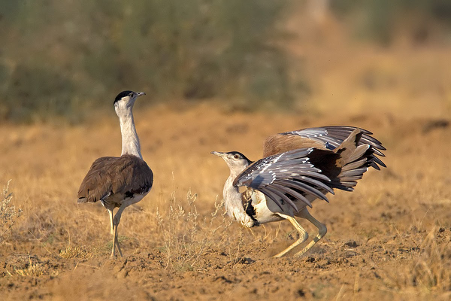The Great Indian Bustard in Jaisalmer: A Last Refuge for a Vanishing Giant
The Great Indian Bustard (Ardeotis nigriceps) is one of the most critically endangered bird species in the world today. Known for its tall, upright stance and stately gait, it is a symbol of India’s rich natural heritage and an indicator of the health of grassland ecosystems. Once widespread across the Indian subcontinent, it now survives in perilously low numbers. The Desert National Park (DNP) near Jaisalmer, Rajasthan, holds the largest remaining population and is the species’ last stronghold.
Physical Characteristics and Behavior
The Great Indian Bustard is one of the heaviest flying birds in the world, with adult males weighing up to 15 kg and standing about a meter tall. It has a distinctive appearance, marked by a black crown on the head, a pale neck, and a white body with brown wings. During the breeding season, males are known for their unique booming calls and elaborate displays where they inflate their throat sacs to attract females.
These birds are primarily ground-dwelling and prefer flat, open landscapes like semi-arid grasslands and scrub desert. They are omnivorous, feeding on insects such as grasshoppers and beetles, seeds, berries, and even small reptiles. Due to their shy and elusive nature, spotting one in the wild is a rare and special experience.
Jaisalmer’s Role in Conservation
Jaisalmer, located in the heart of the Thar Desert, offers one of the last suitable habitats for the Great Indian Bustard. The Desert National Park, spread over 3,000 square kilometers, is a mix of grasslands, salt flats, and sand dunes, providing ideal breeding and feeding grounds. Areas like Sudasari, Sam, and Ramdeora within the park are especially important for the species.
However, the bustard’s habitat has been under constant pressure from human activities. Agricultural expansion, overgrazing, and infrastructure development—especially power lines—pose major threats. One of the leading causes of bustard mortality in recent years has been collision with overhead power lines, which are difficult for the low-flying birds to detect.
Conservation Initiatives
Recognizing the urgency, the Indian government, in partnership with the Wildlife Institute of India (WII) and the Rajasthan Forest Department, launched the Project Great Indian Bustard. A major milestone in this effort was the establishment of a conservation breeding center at Sam, near Jaisalmer. This center focuses on captive breeding, with the long-term goal of reintroducing birds into the wild.
In addition, a landmark decision by the Supreme Court of India has ordered that power lines in core bustard habitats be placed underground to prevent further bird deaths. This decision is seen as a major victory for conservationists and has already begun to show positive results.
Ecotourism and Community Involvement
Birdwatchers and nature lovers travel to Jaisalmer in hopes of catching a glimpse of this rare bird. The best time to visit is from November to February, when the weather is cooler and bird activity is higher. Safaris into the Desert National Park, especially at sunrise or sunset, offer the best chances for sightings.
Local communities also play a vital role in the conservation of the bustard. Awareness programs and eco-tourism initiatives are being developed to involve villagers in protecting the bird while also creating livelihood opportunities.
A Symbol of Hope
The Great Indian Bustard is more than just a bird; it is a symbol of India’s vanishing grasslands and the need for sustainable coexistence between humans and nature. Jaisalmer, with its unique desert landscape, stands at the center of this conservation battle. Though the numbers are low, the intensive efforts by scientists, government agencies, and local communities offer a glimmer of hope.
Saving the Great Indian Bustard is not just about preventing the extinction of a single species—it is about preserving an entire ecosystem. As conservation efforts continue to evolve, Jaisalmer may well be remembered as the place where India turned the tide for one of its most iconic birds.
